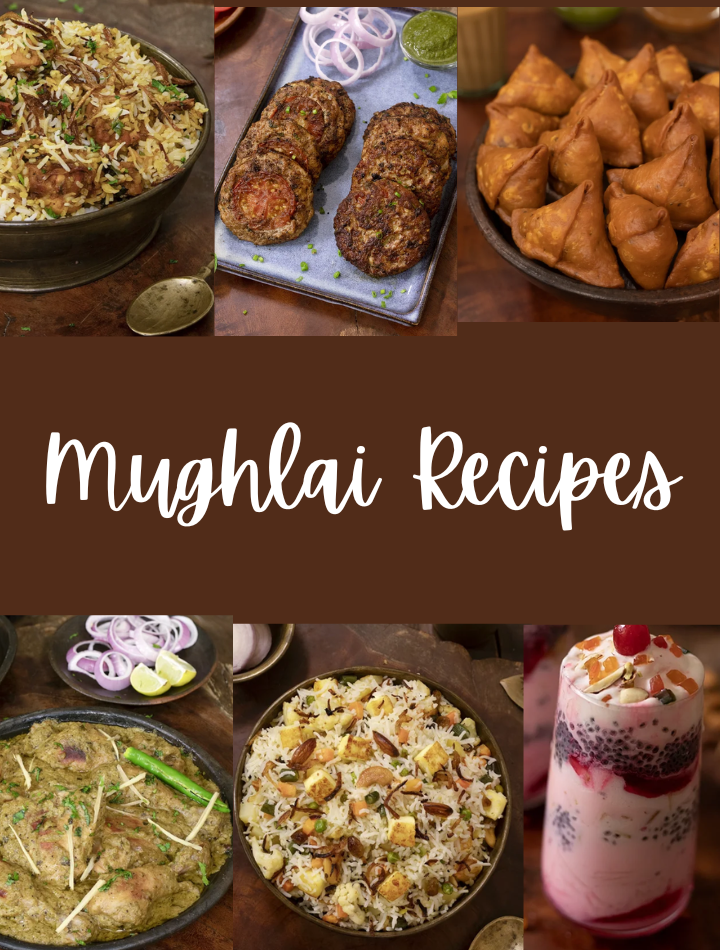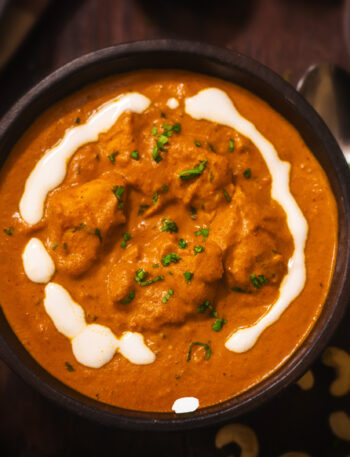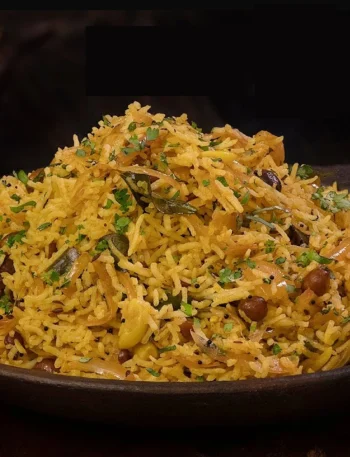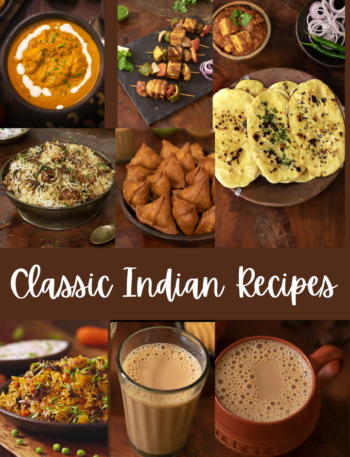Mughal cuisine is one of the most celebrated culinary traditions in South Asia. When the Mughals established their empire in the Indian subcontinent in the early 16th century, they brought with them not just political power but also a culinary transformation. Their love for rich flavors, aromatic spices, and detailed cooking methods shaped what we now recognize as Mughal cuisine. The Mughals were not just rulers; they were patrons of art, architecture, and food, turning cooking into a refined art.
What is Mughal Cuisine?
Mughal cuisine is a mix of Persian, Turkish, and Indian influences. It is known for its rich, creamy gravies, slow-cooked meats, balanced use of spices, and elaborate preparation. Unlike some Indian cuisines that emphasize heat, Mughal dishes focus on deep flavors and a smooth blend of ingredients.
Presentation was key in Mughal cooking. Dishes often included nuts, dried fruits, and expensive ingredients like saffron and rose water. Meat, especially lamb and chicken, played a big role, but vegetarian options were also created to suit different communities within the empire.
History of Mughals and the Birth of Indo-Persian Fusion
The Mughal Empire was founded by Babur in 1526 after he defeated the Sultan of Delhi. Over the next two centuries, rulers like Akbar, Jahangir, Shah Jahan, and Aurangzeb expanded their rule across India.
Mughal cuisine was born from the blending of Persian, Turkish, and Indian culinary traditions. The Mughals brought Central Asian cooking styles, which mixed with Indian spices and cooking techniques. Persian slow-cooking met Indian marination, and Turkish grilling combined with local flavors, creating a new and rich food tradition.
Akbar, known for his cultural inclusivity, encouraged this fusion. His marriage to Rajput princesses introduced more Indian ingredients and vegetarian influences into Mughal cooking. By the time of Shah Jahan, Mughal cuisine had reached its peak, with elaborate dishes requiring days of preparation served at grand feasts.
The Royal Mughal Kitchen
The Mughal royal kitchen, known as the Shahi Bawarchi Khana, was an elaborate and highly organized institution. It was divided into different sections, each specializing in specific types of food preparation. There were separate departments for baking, grilling, confectionery, and brewing beverages. Hundreds of chefs, known as bawarchis and rakabdars, worked under the supervision of the Mir Bakawal, the chief cook, ensuring the highest standards of culinary excellence.
Meals were prepared with great care, often taking days to perfect. Ingredients were sourced from different regions, with the best spices coming from Kerala, saffron from Kashmir, and dry fruits from Persia and Afghanistan. Cooking techniques were meticulously followed, and many recipes remained closely guarded secrets, passed down through generations of royal cooks.
The presentation of food was equally important. Meals were served on silver and gold platters, accompanied by fragrant rose water and edible silver or gold foil (varq) for decoration. The royal dining experience was enhanced with music, poetry, and storytelling, making each meal a grand affair.
Mughal Culinary Traditions
Several key traditions define Mughal cooking
- Dum Pukht (Slow Cooking): This technique involves sealing food in a pot and slow-cooking it over low heat. This allows flavors to blend deeply while keeping the food moist and aromatic.
- Balanced Use of Spices: Mughal dishes use spices for depth rather than just heat. Spices are often roasted or fried before being added at precise moments to bring out their best flavors.
- Layered Cooking: Many Mughal dishes involve cooking ingredients separately before layering them together for the final dish. This helps maintain texture and taste.
- Aesthetic Presentation: Food was not just for eating; it had to look beautiful. Garnishes included silver or gold leaf, dried fruits, and fresh herbs. Special serving dishes were used to enhance visual appeal.
- Secret Recipes: Many Mughal dishes were closely guarded secrets, passed down within royal kitchens and kept exclusive to the imperial court.
Ingredients Used and Their Significance
Mughal cuisine relied on rich ingredients, chosen for both taste and health benefits
- Saffron – Added for its unique aroma, color, and medicinal properties.
- Dry Fruits & Nuts – Almonds, cashews, pistachios, and raisins enhanced the richness of dishes.
- Aromatic Spices – Cardamom, cloves, cinnamon, and nutmeg created complex flavors.
- Ghee & Butter – Used for cooking and flavor enhancement.
- Meat (Lamb, Chicken, and Beef) – Often marinated and slow-cooked for tenderness.
What Royals Loved on Their Plates
Each Mughal ruler had unique food preferences that influenced royal dining traditions
- Babur – Preferred simple, Central Asian dishes like kebabs and lamb stews, as he found Indian food too spicy.
- Akbar – Enjoyed a mix of vegetarian and non-vegetarian dishes, favoring dishes like khichdi, dal, and rich meat curries.
- Jahangir – Loved exotic dishes and was particularly fond of fish, roast meats, and innovative fruit-based desserts.
- Shah Jahan – Had a taste for luxurious dishes like biryani, korma, and shahi tukda, reflecting the grandeur of his reign.
- Aurangzeb – Preferred a simpler diet with less opulence, favoring roti, dal, and mildly spiced dishes.
The Mughal queens also had distinct culinary influences
- Mumtaz Mahal – Inspired the creation of nihari, a slow-cooked meat stew, meant to nourish soldiers.
- Jahanara Begum – Enjoyed delicate sweet dishes like sheer khurma and falooda.
- Noor Jahan – Known for her refined taste, she introduced Persian influences in Mughal desserts and drinks.
Mughal Culinary Influences
Mughal cuisine has left a lasting impact on South Asian food culture. Many of its dishes and techniques influence Indian, Pakistani, and Bangladeshi cuisine today. The use of slow-cooking, rich gravies, and marinated meats continues in Awadhi, Hyderabadi, and Kashmiri cuisines.
Popular Mughal Dishes
Some of the most famous dishes from the Mughal era include
- Biryani – Fragrant rice layered with marinated meat and saffron.
- Korma – A creamy, spiced meat or vegetable dish.
- Shahi Tukda – A dessert of fried bread soaked in sweetened milk and topped with nuts.
- Murg Musallam – Whole chicken stuffed with eggs, spices, and nuts, slow-cooked to perfection.
- Rogan Josh – A flavorful lamb curry with Kashmiri red chilies.
- Seekh Kebabs – Minced meat skewers grilled to smoky perfection.
Mughal cuisine is more than just food — it is a legacy of the empire’s love for rich, flavorful, and beautifully presented meals. It continues to be a vital part of South Asian food culture, enjoyed at grand celebrations and everyday meals alike.
Whether it’s a plate of aromatic biryani or a creamy korma, Mughal cuisine remains a timeless culinary treasure.
Mughal Thali Menu
How to Set Up a Mughal Thali – A Royal Feast Experience
A Mughal thali is more than just a meal. It’s a story of legacy, luxury, and lavish flavors — a fine balance of rustic charm and royal indulgence. Drawing inspiration from the grandeur of the Mughal empire, this spread brings together a series of dishes known for their richness, layered spices, and complex cooking methods. Here’s how to bring together a memorable Mughal-inspired thali at home, with each dish playing a specific role on the plate.
Starters
Mini Samosa
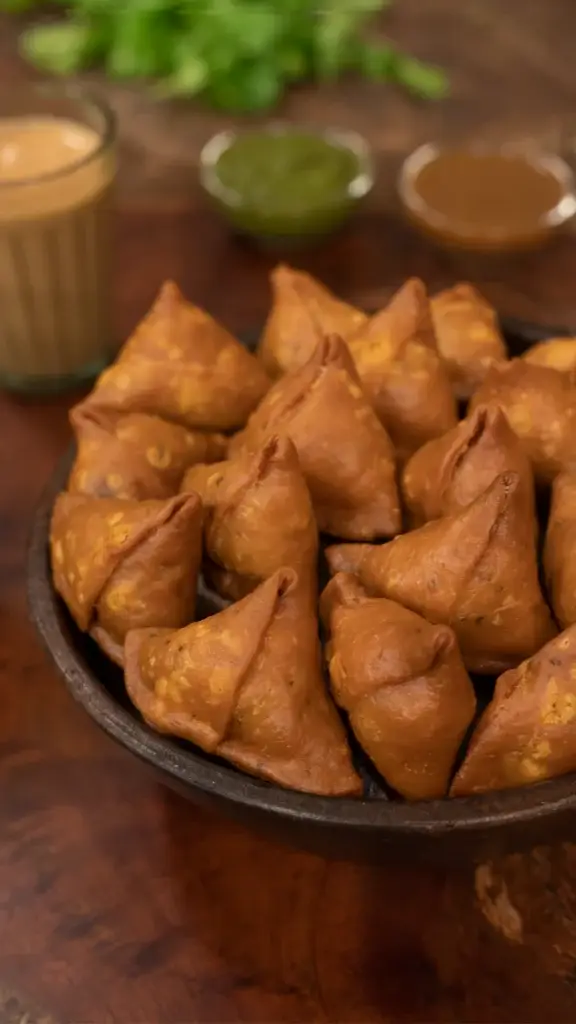
Start the meal with a crisp, savory bite. These mini samosas offer a flaky exterior and a spicy, flavorful filling that instantly awakens the palate. They’re light enough to be enjoyed as a nibble but packed with enough flavor to set the stage for the main courses.
Peshawari Chicken Kebab
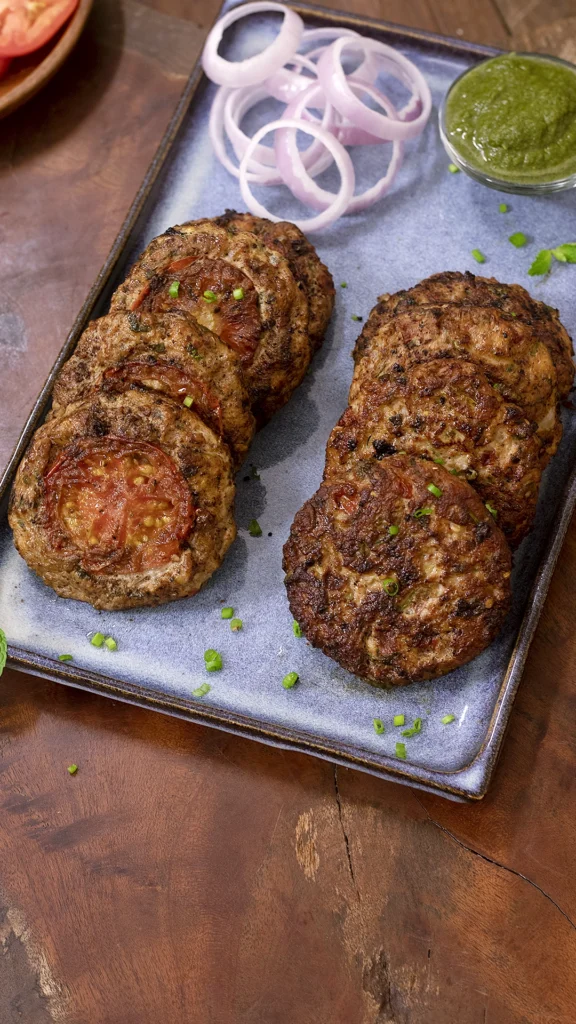
These succulent kebabs are marinated in a rich blend of yogurt, spices, and cream, then grilled to a smoky finish. The result is a tender, melt-in-mouth starter that pairs beautifully with mint chutney. It adds a bold, protein-rich component to the starter selection.
Main Course
Chicken Tikka Biryani

A classic showstopper. Layers of fragrant basmati rice, succulent chicken tikka, and caramelized onions come together in this indulgent biryani. The charred, spiced chicken pieces infuse the rice with a deep, smoky flavor that feels nothing short of celebratory.
Navratan Pulao
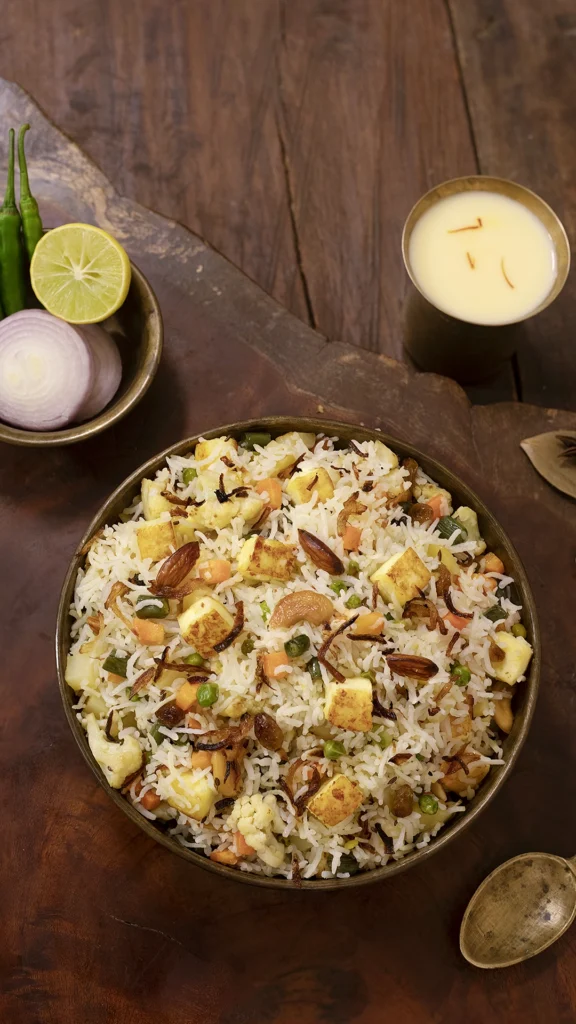
This royal vegetarian pulao is rich with textures — cashews, raisins, paneer, and a colorful mix of vegetables. Saffron adds a floral note while the nuts bring sweetness and crunch. It’s a delicate, mildly spiced counterpoint to the heavier biryani.
Kashmiri Pulao
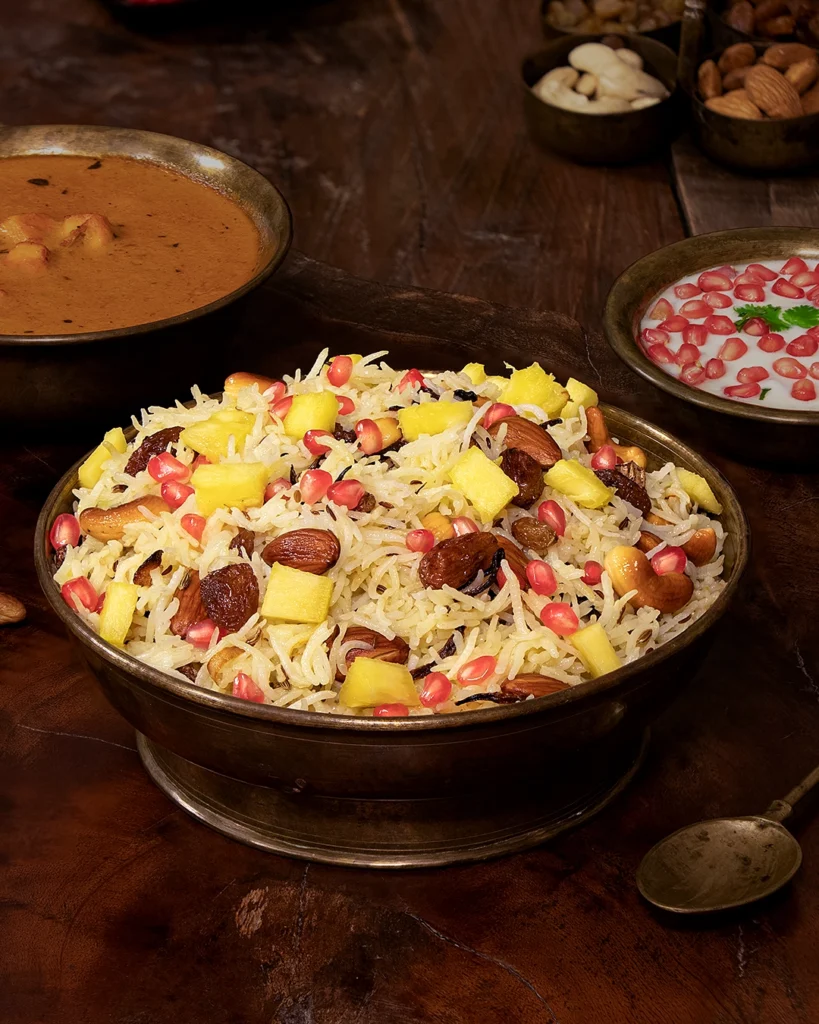
If you want to go the extra mile, add this mildly sweet rice dish, enriched with fruits and nuts. It brings a unique floral-fruity aroma to the thali and works as a beautiful bridge between the savory mains and dessert.
Afghani Paneer
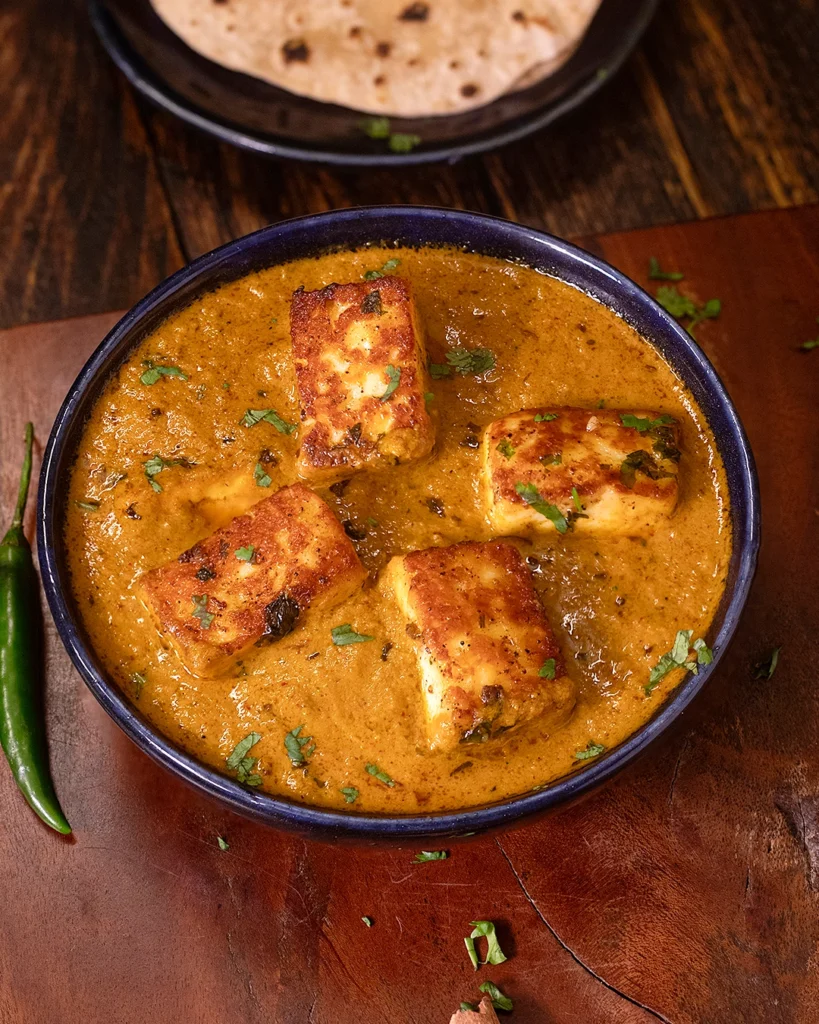
Creamy, mellow, and luxuriously rich, Afghani paneer balances the spices in the rice dishes. Its velvety white gravy, made with nuts and dairy, coats soft paneer cubes and brings in a subtle, comforting richness that rounds out the plate.
Afghani Chicken
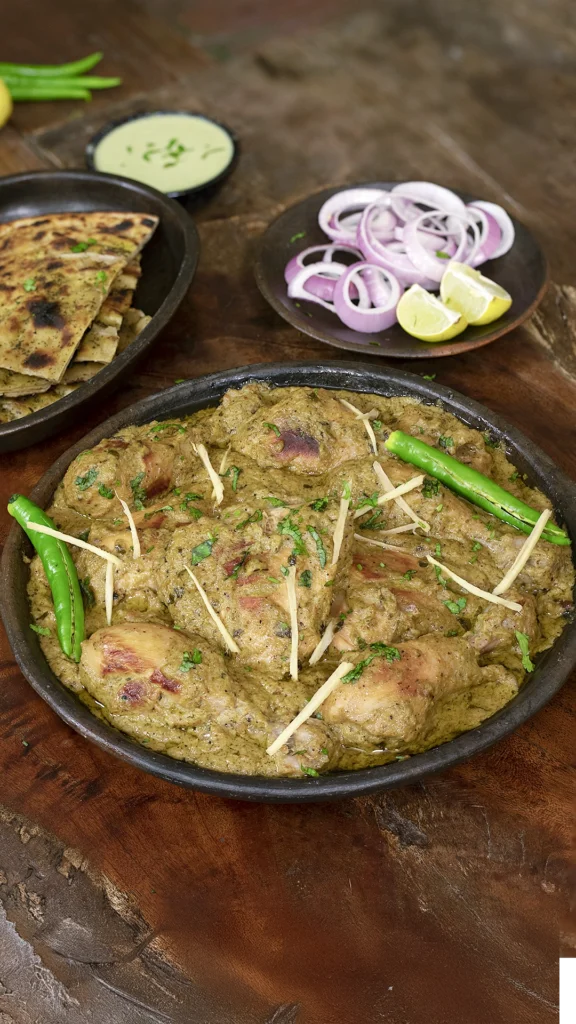
Afghani Chicken is a rich and creamy dish that hails from Afghan cuisine but has become a popular favorite in Mughal-inspired meals. The chicken is marinated in a luscious mix of yogurt, cream, and aromatic spices, creating a tender and flavorful texture. Grilled or baked to perfection, the smoky essence paired with the creamy marinade results in a succulent, melt-in-your-mouth experience. It is a great addition to a Mughal thali, offering a rich, indulgent taste.
Dessert
Royal Falooda
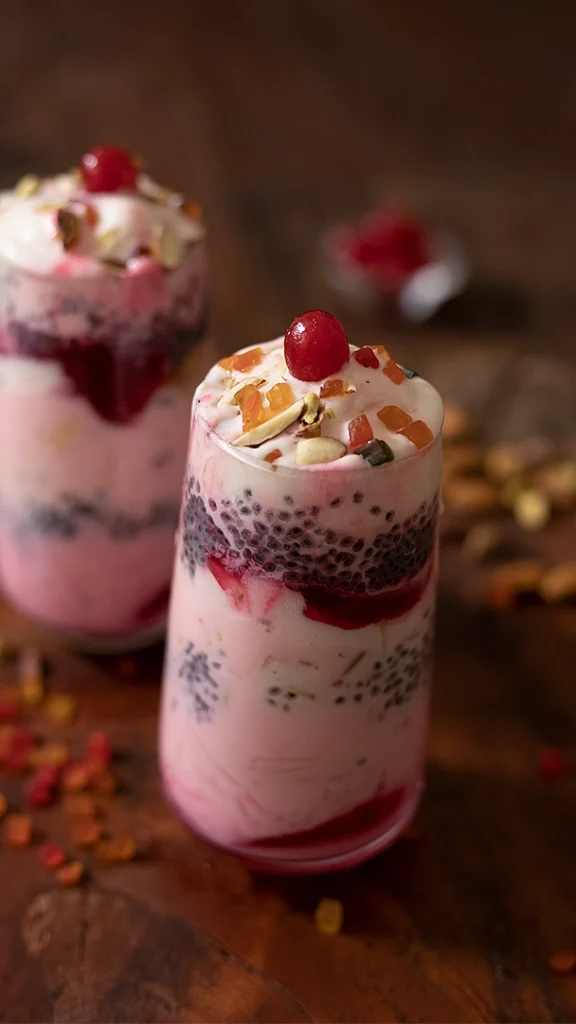
No Mughal thali is complete without a chilled glass of falooda. Layered with basil seeds, rose syrup, vermicelli, and creamy milk — it’s a dessert that’s indulgent yet refreshing. It cleanses the palate while still maintaining the richness of the meal.
Putting It All Together
A well-balanced Mughal thali plays with contrast — crisp and creamy, spicy and mild, rich and refreshing. Make sure to serve the hot items freshly prepared, the pulaos fluffed and garnished, and the falooda pre-chilled. Use elegant platters and traditional bowls to keep the visual appeal on point. Garnishes like mint, fried onions, saffron strands, and rose petals can elevate the presentation with very little effort.
This thali isn’t just food — it’s an experience. Serve it on special occasions or festive dinners when you want your guests to feel pampered and remembered.

